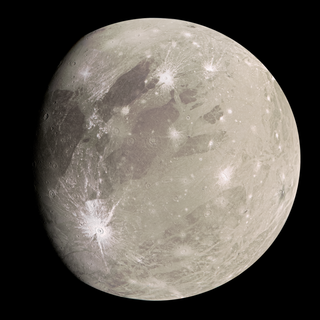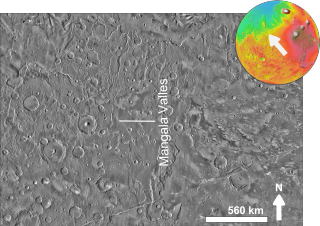Related Research Articles

Callisto, or Jupiter IV, is the second-largest moon of Jupiter, after Ganymede. In the Solar System it is the third-largest moon after Ganymede and Saturn's largest moon Titan, and as large as the smallest planet Mercury, though only about a third as massive. Callisto is, with a diameter of 4821 km, roughly a third larger than the Moon and orbits Jupiter on average at a distance of 1883000 km, which is about six times further out than the Moon orbiting Earth. It is the outermost of the four large Galilean moons of Jupiter, which were discovered in 1610 with one of the first telescopes, being visible from Earth with common binoculars.

Europa, or Jupiter II, is the smallest of the four Galilean moons orbiting Jupiter, and the sixth-closest to the planet of all the 95 known moons of Jupiter. It is also the sixth-largest moon in the Solar System. Europa was discovered independently by Simon Marius and Galileo Galilei and was named after Europa, the Phoenician mother of King Minos of Crete and lover of Zeus.

Ganymede, or Jupiter III, is the largest and most massive natural satellite of Jupiter as well as in the Solar System, being a planetary-mass moon. It is the largest Solar System object without an atmosphere, despite being the only moon of the Solar System with a magnetic field. Like Titan, it is larger than the planet Mercury, but has somewhat less surface gravity than Mercury, Io or the Moon.

Rhea is the second-largest moon of Saturn and the ninth-largest moon in the Solar System, with a surface area that is compareable to the area of Australia. It is the smallest body in the Solar System for which precise measurements have confirmed a shape consistent with hydrostatic equilibrium. It was discovered in 1672 by Giovanni Domenico Cassini.

Oberon, also designated Uranus IV, is the outermost major moon of the planet Uranus. It is the second-largest, with a surface area that is compareable to the area of Australia, and second most massive of the Uranian moons, and the ninth most massive moon in the Solar System. Discovered by William Herschel in 1787, Oberon is named after the mythical king of the fairies who appears as a character in Shakespeare's A Midsummer Night's Dream. Its orbit lies partially outside Uranus's magnetosphere.

Dione, also designated Saturn IV, is the fourth-largest moon of Saturn. Its trailing hemisphere is marked by large ice cliffs called chasmata and is also darkened compared to the leading hemisphere. Based on its density, Dione’s interior is likely a combination of silicate rock and water ice in nearly equal parts by mass. The moon was discovered by Italian astronomer Giovanni Domenico Cassini in 1684 and is named after the Titaness Dione in Greek mythology.

The Mangala Valles are a complex system of criss-crossing channels on Mars, located in the Tharsis region and in the Memnonia quadrangle. They originated in the Hesperian and Amazonian epochs. They are thought to be an outflow channel system, carved by catastrophic floods, and the release of vast quantities of water across the Martian surface. This flooding was probably initiated by tectonic stretching and the formation of a graben, Mangala Fossa, at the channels' head, perhaps breaching a pressurized aquifer trapped beneath a thick "cryosphere" beneath the surface. The Mangala Valles contain several basins; after they filled, the overflow went through a series of spillways. One source of waters for the system was the Memonia Fossae, but water also probably came from a large basin centered at 40 degrees S.
Radioglaciology is the study of glaciers, ice sheets, ice caps and icy moons using ice penetrating radar. It employs a geophysical method similar to ground-penetrating radar and typically operates at frequencies in the MF, HF, VHF and UHF portions of the radio spectrum. This technique is also commonly referred to as "Ice Penetrating Radar (IPR)" or "Radio Echo Sounding (RES)".

A planetary-mass moon is a planetary-mass object that is also a natural satellite. They are large and ellipsoidal in shape. Two moons in the Solar System are larger than the planet Mercury : Ganymede and Titan, and seven are larger and more massive than the dwarf planets Pluto and Eris.
Susan Y. Schwartz is a scientist at the University of California, Santa Cruz known for her research on earthquakes, through field projects conducted in locations in Costa Rica and the San Andreas Fault.

A planetary surface is where the solid or liquid material of certain types of astronomical objects contacts the atmosphere or outer space. Planetary surfaces are found on solid objects of planetary mass, including terrestrial planets, dwarf planets, natural satellites, planetesimals and many other small Solar System bodies (SSSBs). The study of planetary surfaces is a field of planetary geology known as surface geology, but also a focus on a number of fields including planetary cartography, topography, geomorphology, atmospheric sciences, and astronomy. Land is the term given to non-liquid planetary surfaces. The term landing is used to describe the collision of an object with a planetary surface and is usually at a velocity in which the object can remain intact and remain attached.

A subsatellite, also known as a submoon, or a schmoon, is a "moon of a moon" or a hypothetical natural satellite that orbits the moon of a planet.

Margaret Galland Kivelson is an American space physicist, planetary scientist, and distinguished professor emerita of space physics at the University of California, Los Angeles. From 2010 to the present, concurrent with her appointment at UCLA, Kivelson has been a research scientist and scholar at the University of Michigan. Her primary research interests include the magnetospheres of Earth, Jupiter, and Saturn.
Planetary oceanography also called astro-oceanography or exo-oceanography is the study of oceans on planets and moons other than Earth. Unlike other planetary sciences like astrobiology, astrochemistry and planetary geology, it only began after the discovery of underground oceans in Saturn's moon Titan and Jupiter's moon Europa. This field remains speculative until further missions reach the oceans beneath the rock or ice layer of the moons. There are many theories about oceans or even ocean worlds of celestial bodies in the Solar System, from oceans made of diamond in Neptune to a gigantic ocean of liquid hydrogen that may exist underneath Jupiter's surface.

Mangala Fossa is a graben in the Memnonia quadrangle of Mars, located near 11.6°S 151.0°W, which originated in the Hesperian and Amazonian epochs. The graben is located at the head of the outflow channel Mangala Valles, which is thought to have been formed by at least two catastrophic flood events during the same geological period, leading to the release of vast quantities of water from Mangala Fossa onto the Martian surface. The flooding was probably initiated by the emplacement of a dike radiating from the volcano Arsia Mons, resulting in the formation of the graben, Mangala Fossa, at the channels' head. This dike breached a pressurized aquifer trapped beneath a thick "cryosphere" beneath the surface. As the floor of the graben subsided, water found its way up one or both of the faults in the crust that defined the edges of the graben and spilled into the depression, eventually filling it and overflowing at the lowest point on the rim to erode the Mangala Valles channels.
Maureen D. Long is an observational seismologist studying mantle and Mesosphere dynamics. She currently serves as a professor at Yale University within the Department of Geology and Geophysics.

Lynnae C. Quick is an American planetary geophysicist and Ocean Worlds Planetary Scientist at NASA Goddard Space Flight Center. Her research centers on theoretical modeling of cryovolcanic processes on the icy moons and dwarf planets in the Solar System as well as modeling volcanic activity on Venus and the Moon. Quick is a member of the Dawn, Europa Clipper, and Dragonfly Mission science teams. She is also a member of the NASA Solar System Exploration Research Virtual Institute (SSERVI) Toolbox for Research and Exploration (TREX) team, and serves as co-chair of the Earth and Planetary Systems Sciences section of the National Society of Black Physicists.
Karen Fischer is an American seismologist known for her research on the structure of Earth's mantle, its lithosphere, and how subduction zones change over geologic history.
Michelle F. Thomsen is space physicist known for her research on the magnetospheres of Earth, Jupiter, and Saturn.
References
- 1 2 3 "Dr. Amy C. Barr Mlinar | Planetary Science Institute". www.psi.edu. Retrieved 2016-06-16.
- 1 2 3 "Amy Barr | News from Brown". news.brown.edu. Retrieved 2016-06-16.
- ↑ "Planetary Science Institute Researchers to Study Jupiter's Moon Europa | Planetary Science Institute". www.psi.edu. Retrieved 2016-06-16.
- ↑ Than, Ker. "Does Icy Pluto Have a Hidden Ocean? New Horizons Offers New Clues". Smithsonian. Retrieved 2016-06-16.